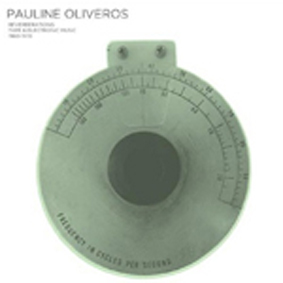Pauline Oliveros, "Reverberations: Tape & Electronic Music 1961-1970"
 This has got to be one of the most improbable, altruistic, and quixotic box sets ever produced, as it compiles 12 albums worth of almost entirely unreleased material from Oliveros' fertile early years.  That, of course, means: 1.) none of her early masterpieces like "Bye Bye Butterfly" are here, and 2.) nothing at all is included from the wildly different (and superior) work that she has done over the last four decades.  Those caveats, coupled with the inarguable fact that no artist on earth has a dozen killer albums worth of vault material lying around, makes this a pretty undesirable prospect for the merely curious or for anyone looking for a definitive retrospective.  For serious fans of early electronic music, however, this is an absolute goldmine.
This has got to be one of the most improbable, altruistic, and quixotic box sets ever produced, as it compiles 12 albums worth of almost entirely unreleased material from Oliveros' fertile early years.  That, of course, means: 1.) none of her early masterpieces like "Bye Bye Butterfly" are here, and 2.) nothing at all is included from the wildly different (and superior) work that she has done over the last four decades.  Those caveats, coupled with the inarguable fact that no artist on earth has a dozen killer albums worth of vault material lying around, makes this a pretty undesirable prospect for the merely curious or for anyone looking for a definitive retrospective.  For serious fans of early electronic music, however, this is an absolute goldmine.
The length and breadth of Pauline Oliveros' career is pretty astonishing by any standard, as she has essentially lived two equally visionary, yet totally disparate, creative lives.  Superficially, the pieces collected here have zero relation to my previous conception of Pauline as an artist.  In fact, it is difficult to imagine her even listening to music like this, let alone creating it (and so much of it besides).  The reason for that is the sheer artificiality inherent in creating sounds solely from oscillators, wave generators, and modular synthesizers.  Oliveros' work over the last several decades seems aggressively antithetical to anything resembling inhuman buzzes and bleeps, instead employing an almost entirely organic palette centered around her iconic accordion and an array of collaborators.  On a deeper level, however, it all makes sense: she just found a different way to explore her lifelong fascination with acoustics, the fluidity of time, and the way masses of frequencies interact with each other.  Her means have a consistent thread as well, as her technological creativity is now employed to find ways to make very human and "real" sounds seem hyper-real.
The twelve discs of Reverberations are arranged in chronological order with the location of their origin included as well, which makes following Pauline's trajectory both enticing and easy.  The earliest piece is 1961's "Time Perspectives," a tape-based work that was recorded in Oliveros' home utilizing the acoustic properties of her bathtub.  It is a bit of an anomaly, as it is the set's sole musique concrète piece, mostly derived from water noises and other non-musical sounds.
The next two discs cover 1964-1966, the period in which Pauline, Terry Riley, and others, armed with WWII surplus equipment, founded the San Francisco Tape Music Center.  This period is notable for several reasons.  For one, Pauline recorded one of her greatest pieces during this time, the aforementioned "Bye Bye Butterfly" (not included, sadly).  Secondly, it coincided with her plunge into the world of electronically generated beeps, buzzes, whines, and hums (the "Mnemonics" series), an artistic path that she followed for the duration of this compilation's scope.  Finally, it should be noted that Oliveros had an unusual approach to tape music, eschewing cutting-and-splicing of her peers for an obsession with tape-based delay and an insistence upon pieces that could be replicated live and in real-time.
Later in 1966, Pauline headed to the University of Toronto's Electronic Music Studio, which was much better equipped.Even though she was there less than a year, this was a hugely productive period for her and comprises five entire discs of the set.  This is where things start to get interesting, both from a musical perspective and a theoretical one.  Musically, the various electronic hums and whines that characterized her Tape Center work are used for far more ambitious, vibrant, and complexly textured compositions–this is where Pauline's work becomes truly distinctive.  The actual sounds being generated are not noticeably different than those generated in the far more modest San Francisco studio, but the complexity and effectiveness of their interactions is on an entirely different level.
Correspondingly, a few of her more famous works ("Big Mother is Watching You" and "I of IV") originated from this period.  While neither is included, many variations and concurrent works are here, so their absence is not terribly glaring.  Also, some of the less famous pieces are quite visceral and weirdly contemporary-sounding: she could probably still tear the roof off of a noise show with a piece like "The Day I Disconnected the Erase Head and Forgot to Reconnect It."
I was most fascinated, however, by the theory behind Pauline's work at this time, a theory which caused UTEMS' director to accuse her of dabbling in the black arts:  Oliveros set all of the studio's twelve square-wave generators to frequencies outside the range of human hearing, relying on the clashing frequencies to create their own audible sounds (this is called "the heterodyne technique").  She also discovered that the pressure waves caused by unheard high frequency sounds can still be felt and that some frequencies created distortion by interacting with the bias frequency of her tape machines, all of which I found fascinating.
Near the end of 1966, Pauline became the director of the relocated Tape Center at Mills College.  This period takes up 2½ discs and yielded her classic "Alien Bog."  Again, that is not included here, but several other "Bog" variations are and they are pretty weird and divergent compared to what came before them.  In a perverse way, they are the first harbinger of Oliveros' imminent and dramatic change in direction–while they certainly sound as artificial and electronic as ever, they were a conscious attempt to replicate the omnipresent insectoid hum that emerged from the Texas wetlands of her youth.  Her Texan childhood manifests itself in another (more unexpected) way as well, as the liner notes divulge that her love of tape delay is rooted in the echo and delay used in Western Swing and jukebox hits like Les Paul & Mary Ford's "How High the Moon."
Pauline's "Bog-period" bout with mutant naturalism was short-lived, however, as the final two discs plunge into remarkably caustic noise.  This is especially surprising given that they coincide with her acceptance of a teaching position in the music department of UC San Diego.  While the obligations of teaching certainly slowed her creative output (and brought this phase of her career to an end), Pauline's time at UCSD ultimately turned out to be very significant and fruitful philosophically: she befriended physicist Lester Ingber and became extremely interested in how the mind focuses on sound, shaping decades of her work to come.  Also, in a more general way, she simply became increasingly disinterested in the isolated, hermetic world of her studio and more concerned with exploring the potential of both other people and the natural world.
Taken as a solely musical endeavor, Reverberations is a pretty exhausting set with many similar-sounding and very long pieces, but there are certainly some great ones among them (and they are practically all appearing for the first time).  More importantly, however, this set was clearly a labor of love on Important's part and it shows in every way.  I was especially impressed by the liner notes, which were genuinely colorful, understandable, and informative.  Bluntly speaking, there is not a lot of overt personality or variation in how oscillators, wave generators, and early synthesizers sound (regardless of who is playing them), so learning about why and how a piece came into existence enhances the listening experience immeasurably and adds several new layers to appreciate.  Also, I learned some neat Oliveros trivia that made me even more predisposed to enjoy her work, like the fact that she used to play shows with oscillators mischievously and deliberately set to the resonant frequency of the venue, often resulting in a mass exodus. As a result, Reverbations feels far more like an engaging history of a restless and groundbreaking artist than a mere compilation.  I still very much prefer Pauline's later work, but having a deeper understanding of the convoluted path she took to get there makes me appreciate it even more.
Samples:
 
 



